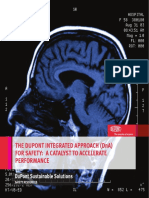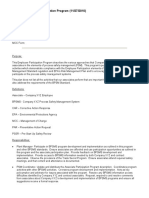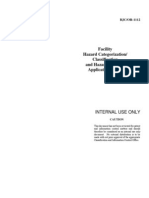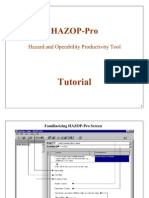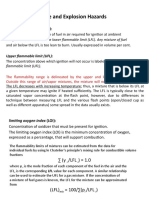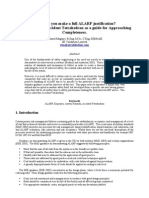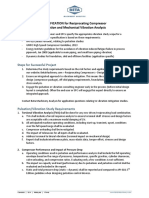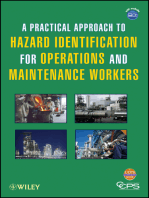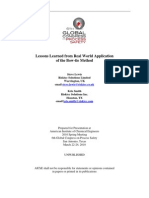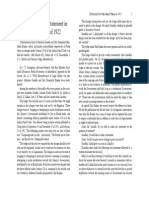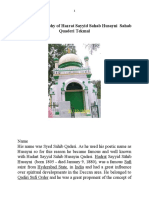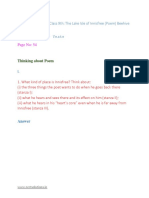2 Process Hazard Analysis
2 Process Hazard Analysis
Uploaded by
SHANZAY21111111Copyright:
Available Formats
2 Process Hazard Analysis
2 Process Hazard Analysis
Uploaded by
SHANZAY21111111Original Description:
Copyright
Available Formats
Share this document
Did you find this document useful?
Is this content inappropriate?
Copyright:
Available Formats
2 Process Hazard Analysis
2 Process Hazard Analysis
Uploaded by
SHANZAY21111111Copyright:
Available Formats
Preventing Chemical Accidents
Introduction to Process Hazard Analysis
First Edition
Process Safety Management Training from the NJ Work Environment Council
This material was produced under grant SH-17813-08-60-F-34 from the Occupational Safety and Health Administration, U.S. Department of Labor. It does not necessarily reflect the views or policies of the U.S. Department of Labor, nor does mention of trade names, commercial products, or organizations imply endorsement by the U.S. Government. This curriculum is revised from materials originally developed by the United Steelworkers Tony Mazzocchi Center for Safety, Health, and Environmental Education and produced by the Steelworkers Charitable and Educational Organization, funded in whole or in part with funds from the Occupational Safety and Health Administration, U.S. Department of Labor (grant number SH-16632-07-60-F-42).
Preventing Chemical Accidents: Introduction to Process Hazard Analysis
Table of Contents
About WEC Preventing Chemical Accidents The Small Group Activity Method The Factsheet Reading Method Activity: Introduction to Process Hazard Analysis Task 1 Task 2 Evaluation 2 13 21 ii iii iv vi 1
Preventing Chemical Accidents: Introduction to Process Hazard Analysis
About WEC
The New Jersey Work Environment Council (WEC) is a non-profit collaboration of organizations working for safe, secure jobs, and a healthy, sustainable environment. Visit WECs website at www.njwec.org For more information about WEC programs and services, contact: Rick Engler, Director New Jersey Work Environment Council 142 West State Street - Third Floor, Trenton, NJ 08608-1102 Telephone: (609) 695-7100 Fax: (609) 695-4200 E-mail: info@njwec.org
ii
Preventing Chemical Accidents: Introduction to Process Hazard Analysis
Preventing Chemical Accidents
Unexpected releases of highly hazardous toxic, reactive, or flammable chemicals create the possibility of a disaster for workers, employers, and communities. OSHAs Process Safety Management Standard helps prevent accidental releases of highly hazardous chemicals, thus protecting employees, as well as plant neighbors. Effective worker training about PSM helps achieve safer, healthier, and more productive workplaces. In New Jersey, PSM regulates approximately 100 facilities, including certain chemical plants, oil refineries, food processors, electric utilities, warehouses, and public and private sector water and sewage treatment operations. PSM may also cover other types of facilities. PSM has special provisions for contractors working in covered facilities. WECs training curriculum covers key aspects of the PSM standard. Training introduces the concept of systems of safety and accident prevention and why facilities should establish an organizational structure to oversee PSM implementation. WEC addresses OSHAs performance-based requirements for a plant mechanical integrity program. Training also covers accident, incident, and near-miss investigations, focusing on root causes. WEC also can provide training on related subjects, such as the New Jersey Toxic Catastrophe Prevention Act (TCPA), employer and worker/union rights to participate during OSHA and TCPA inspections, and development of effective labor-management safety and health committees. For more information, contact: Denise Patel, PSM Outreach Coordinator WEC, 142 West State St, Third Floor Trenton, NJ 08608 Call: (609) 695-7100, Extension 305
iii
Preventing Chemical Accidents: Introduction to Process Hazard Analysis
Fax: (609) 695-4200 E-Mail: dpatel@njwec.org
iv
Preventing Chemical Accidents: Introduction to Process Hazard Analysis
The Small Group Activity Method
Basic Structure The Small Group Activity Method* is based on a series of problemsolving activities. An activity can take from 45 minutes to an hour. Each activity has a common basic structure: Small Group Tasks Report-Back Summary 1. Small Group Tasks: The training always begins with groups working together at their tables. Each activity has a task, or set of tasks, for the groups to work on. The task asks that the groups use their experience and the factsheets to solve problems and make judgements on key issues. 2. Report-Back: For each task, the group selects a scribe that takes notes on the small group discussion and reports back to the class as a whole. During the report-back, the scribe informs the entire class as to how his or her group solved the particular problem. The trainer records each scribes report-back on large pads of paper in front of the class so that everyone can refer to them. 3. Summary: Before the discussion drifts too far, the trainer needs to bring it all together during the summary. Here, the trainer highlights the key points of the activity and brings up any problems or points that may have been overlooked during the report-back.
*The Small Group Activity Method (SGAM) is based on a training procedure developed by Englands Trades Union Congress (TUC) in the 1970s. The Labor Institute and Oil, Chemical, and Atomic Workers Union (now part of the United
Preventing Chemical Accidents: Introduction to Process Hazard Analysis Steelworkers) used a similar method around economic and health and safety
er developed the procedure into SGAM. The New Jersey Work Environment Council has used SGAM since 1986.
issues for workers and furth
Three Basic Learning Exchanges The Small Group Activity Method (SGAM) is based on the idea that every training is a place where learning is shared. With SGAM, learning is not a one-way street that runs from trainer to worker. Rather SGAM is a structured procedure that allows us to share information. It is based on three learning exchanges: Worker-to-Worker Worker-to-Trainer Trainer-to-Worker Worker-to-Worker: Most of us learn best from each other. SGAM is set up in such a way as to make the worker-to-worker exchange a key element of the training. The worker-to-worker exchange allows participants to learn from each other by solving problems in their small groups. Worker-to-Trainer: Lecture-style training assumes that the trainer knows all the answers. With SGAM it is understood that the trainers also have a lot to learn and this is the purpose of the worker-to-trainer exchange. It occurs during the report-back and it is designed to give the trainer an opportunity to learn from the participants. Trainer-to-Worker: This is the trainers opportunity to clear up any confusion and make points they think are key. By waiting until the summary section, trainers know better what people need to know.
vi
Preventing Chemical Accidents: Introduction to Process Hazard Analysis
The Factsheet Reading Method
The process described below focuses everyone on the important information in the factsheets. The process is as follows: First, select a scribe for this Task. Each of you will be assigned a small number of factsheets to read. You will then share the factsheet information with your table. Your trainer will assign your individual factsheets this way: Starting with the scribe and moving to the left, count out loud from 1 to 8. Keep going around the table until all numbers (factsheets) are distributed. The assigned numbers correspond to Factsheets 1 through 8 on the following pages. Once everyone has read their assigned factsheets individually, your scribe will go around the table and ask each of you to explain to the group what you have learned. Factsheets should be explained in the order assigned (1 through 8), since the factsheets build on the previous one. In this way, we all start at the same place and with the same information.
vii
Preventing Chemical Accidents: An Introduction to Process Hazard Analysis
An Introduction to Process Hazard Analysis
Purposes:
To understand how process hazard analysis (PHA) can be used as a tool to prevent accidents. To learn about the importance of considering worst-case scenarios. This Activity has two tasks.
Preventing Chemical Accidents: An Introduction to Process Hazard Analysis
Task 1 Scenario:
Recently, the K-l polymerization unit at OilChem Corporation exploded, killing three workers. An investigation showed that a pressure control system on a feed line to the reactor, which was designed to keep the feed under pressure and in a liquid state, failed, allowing the feed to vaporize. The vaporized feed continued to flow into the reactor. The flow control meter on the feed line did not register the vaporized feed as a flow, causing the operator to believe that a high-level alarm on the reactor was false. As a result, the operator by-passed the safety interlock on the feed line, causing the vessel to over-pressurize and explode. OilChem says that they were in compliance with the PSM Standard and that they were in the process of conducting the required PHAs. The initial OSHA investigation uncovered the following facts: The K-l unit was the oldest processing unit on the site. The K-l unit had a history of having the most runaway chemical reactions of any unit on the site. The pressure control system on the feedstock line had a history of repeated failures. The level control alarm was bypassed continuously because of its poor reliability. The pressure relief system was inadequately designed for the chemical process run in the reactor. OilChem had completed PHAs on all of the sites storage tanks. No PHAs had been completed for the chemical processes on site.
2
Preventing Chemical Accidents: An Introduction to Process Hazard Analysis
There was no employee involvement in the development of the PHA priority list.
Task 1
Your group has been appointed to the incident investigation team. In your groups, choose a scribe. Then, using Factsheets 1 - 7 on pages 5 11 and your own experience, answer the following questions. 1. According to the PSM Standard, what did OilChem do wrong?
2. Would a PHA on the K-l unit have uncovered any of the root causes of the accident? If so, what PHA method or combination of methods should have been used (see Factsheet 2) and what causes would they have exposed?
Preventing Chemical Accidents: An Introduction to Process Hazard Analysis
Task 1 continued
3. Is OilChem required by OSHA to fix faults in design or operating procedures identified by a PHA? (See Factsheets 5, 6 and 7.) What do you think an effective program for PHA recommendations should look like?
Preventing Chemical Accidents: An Introduction to Process Hazard Analysis
Factsheet #1 What Is a Process Hazard Analysis?
A PHA is defined as: A systematic effort designed to identify and analyze hazards associated with the processing or handling of highly hazardous materials; and A method to provide information which will help workers and employers in making decisions that will improve safety. A PHA analyzes: The potential causes and consequences of fires, explosions and releases of toxic chemicals; and The equipment, instrumentation, human actions and other factors which might affect the process. A PHA attempts to determine: The failure points, methods of operations and other factors that can potentially lead to accidents. A PHA team: Should include engineers, operators, supervisors and other workers who have knowledge of the standards, codes, specifications and regulations which apply to the process being studied.
Preventing Chemical Accidents: An Introduction to Process Hazard Analysis
Source: Adapted from OSHA Process Safety Management Standard, 29 CFR 1910.119, 57 FR 6356, February 24, 1992, Appendix C.
Preventing Chemical Accidents: An Introduction to Process Hazard Analysis
Factsheet #2 Common PHA Methods
The following is a list of some of the common methods used to evaluate process hazards. Checklists This method uses established codes, standards and wellunderstood hazardous operations as a checklist against which to compare a process. A good checklist is dependent on the experience level and knowledge of those who develop it. What If This approach uses a multi-skilled team to create and answer a series of what-if type questions. This method has a relatively loose structure and is only as effective as the quality of the questions asked and the answers given. Hazard and Operability Study (HAZOP) A structured, systematic review that identifies equipment that is being used in a way that it was not designed to be, and which might create hazards or operational problems. HAZOPs are usually conducted by a multi-skilled team that studies piping and instrument diagrams. Each pipeline and vessel is evaluated for certain limitations and deviations in flow, temperature, pressure, etc. Failure Mode and Effect Analysis (FMEA) A systematic study of the consequences of failure (breakdown) of certain operational hardware such as transmitters, controllers, valves, pumps, etc. Fault-Tree Analysis This method draws a picture (model) that shows what undesirable outcomes might result from a specific initiating event (for example, a pipe rupture in a pipe rack). It uses graphics and
Preventing Chemical Accidents: An Introduction to Process Hazard Analysis
symbols to show the possible order of events which might result in an accident. This method is sometimes used in accident investigations to determine probable cause.
Source: The Workplace Health Fund, Blueprint for Prevention, Washington, D. C.
Preventing Chemical Accidents: An Introduction to Process Hazard Analysis
Factsheet #3 The Most Hazardous Processes Are First
OSHA requires employers to perform a PHA on each process covered by the law. The purpose of the PHA is to identify and evaluate the hazards of the process, and ways or methods to control them. The most hazardous processes must be evaluated first. All PHAs must be completed as soon as possible. Also, all PHAs must be updated and revalidated at least every five years.
Preventing Chemical Accidents: An Introduction to Process Hazard Analysis
Source: OSHA Process Safety Management Standard, 29 CFR 1910.119, 57 FR 6356, February 24, 1992.
10
Preventing Chemical Accidents: An Introduction to Process Hazard Analysis
Factsheet #4 Process Experience Is a Must
A process hazard analysis cannot be done by just anyone. According to OSHA, PHAs must be performed by a team with process and engineering knowledge and include at least one employee experienced in running the process. Also, one member of the team must have experience with the PHA method being used. PHAs must address all of the following issues: The hazards of the process; Previous incidents which could have been catastrophic; Engineering and administrative controls; The consequences of failure of engineering and administrative controls; Facility siting; Human factors; and The range of possible safety and health effects caused by the failure of controls.
11
Preventing Chemical Accidents: An Introduction to Process Hazard Analysis
Source: OSHA Process Safety Management Standard, 29 CFR 1910.119, 57 FR 6356, February 24, 1992.
12
Preventing Chemical Accidents: An Introduction to Process Hazard Analysis
Factsheet #5 What Are Engineers Trained to Do?
Hourly workers can have the best understanding of the safety hazards involved in a process. Management staff of oil and chemical plants may consist of some people with degrees in chemical engineering who are less familiar with actual plant operations. Traditionally, production managers have not received training in safety issues and even safety managers may be unfamiliar with primary prevention opportunities.
13
Preventing Chemical Accidents: An Introduction to Process Hazard Analysis
Source: Ashford, Nicholas, The Encouragement of Technological Change for Preventing Chemical Accidents, MIT and EPA Report, 1993, pp. viii-18.
14
Preventing Chemical Accidents: An Introduction to Process Hazard Analysis
Factsheet #6 Take Action and Follow-through
It is not enough for employers to just assure that PHAs have been conducted. They must do something about their findings. The employer should establish a system or set of procedures that will promptly deal with the findings of the PHA team and recommendations. Any actions taken to correct hazards uncovered by the PHA must be communicated to the workers in the area and to any other workers who might be affected. PHAs should be completed as soon as possible, beginning with the most hazardous. However, OSHA has no equivalent time requirements for the implementation of PHA recommendations. Follow-up is a critical part of any PHA, yet this is usually the weakest link in the process. Sometimes recommendations are resolved by a manager just saying no. Some diligent companies prepare quarterly status reports on PHA recommendations and include this in their audit program. Worker safety representatives should be involved in each step of the follow up. An effective process safety program includes workers on the front end and on the follow up.
15
Preventing Chemical Accidents: An Introduction to Process Hazard Analysis
Source: OSHA Process Safety Management Standard, 29 CFR 1910.119, 57 FR 6356, February 24, 1992.
16
Preventing Chemical Accidents: An Introduction to Process Hazard Analysis
Factsheet #7 New Guidelines for the PSM Standard
OSHA has issued the following guidelines for PSM compliance: Where a [PHA] recommendation is rejected, the employer must communicate this to the team, and expeditiously resolve any subsequent recommendation of the team. An employer can justifiably decline to adopt a recommendation where the employer can document in writing and based upon adequate evidence that one or more of the following conditions exist: 1. The analysis upon which the recommendation is based contains material factual errors. 2. The recommendation is not necessary to protect the health and safety of the employers own employees or the employees of contractors. 3. An alternative measure would provide a sufficient level of protection. 4. The recommendation is infeasible. A joint labor-management health and safety committee can review the implementation of recommendations.
17
Preventing Chemical Accidents: An Introduction to Process Hazard Analysis
Source: OSHA PSM Compliance Directive, September 13, 1994.
18
Preventing Chemical Accidents: An Introduction to Process Hazard Analysis
19
Preventing Chemical Accidents: An Introduction to Process Hazard Analysis
Task 2 Scenario:
OilChem and USW Local 2008 have formed a team to do a PHA of a polystyrene unit. In the past, PHA teams have examined only fire potentials as their basis for considering the risk of chemical releases. The new team has been discussing whether or not to expand their review to include unconfined vapor cloud explosions or other potential worst-case incidents. The team is having trouble reaching a consensus on what to do. Some team members have stated that worst-case incident reviews are a waste of time and money, and that they will only serve to scare the surrounding community into demanding that the plant be shut down. In your groups, choose a scribe. Then, using Factsheets 8 12 on pages 14 - 18 and your own experience, answer the following questions: 1. Do you agree or disagree with the team members who do not want to do worst-case incident reviews? Please explain why or why not.
20
Preventing Chemical Accidents: An Introduction to Process Hazard Analysis
Task 2 continued
2. Turning now to your own facilities, what do you think is the most serious worst-case accident that could happen? Would a PHA of the equipment involved in the accident you described help to prevent it from happening? Please explain why.
21
Preventing Chemical Accidents: An Introduction to Process Hazard Analysis
Factsheet #8 The Case for Worst-case Scenarios
Some companies consider only worst-credible scenarios rather than looking at the much more extreme worst-case scenarios. They argue that worst-case incidents are so improbable that they are virtual impossibilities. However, experience with numerous chemical industry disasters has shown that what was thought to be impossible happens all too often. The Environmental Protection Agency requires many PSM-covered facilities to develop Risk Management Plans that include worstcase assessments of hazardous processes. These assessments must assume that all back-up safety systems have failed to work. Their examples include: A transfer hose with no shutoffs fails, resulting in the release of the contents of the vessel or tank it is attached to; Tank piping with no shutoffs fails, resulting in the total release of the tank contents; A flame impingement on a vessel which results in the vessels failing; and A severe vessel over-pressurization caused by contamination, a runaway reaction, or overheating which causes a venting to the atmosphere or a vessel failure.
22
Preventing Chemical Accidents: An Introduction to Process Hazard Analysis
Source: 40 CFR Part 68, Accidental Release Prevention Requirements: Risk Management Programs under the Clean Air Act, Section 112(r)(7).
Factsheet #9 Is the Worst-case Release Only 10 Minutes Long?
An indication of industrys resistance to the development of worst-case scenarios surfaced during a trial application of the EPAs proposed Risk Management Plan rule. Chemical plants in the Kanawha Valley of West Virginia participated in a trial program in June 1994. The companies released maps which showed what worst-case vapor plume releases would look like. Some of the plumes stretched more than 30 miles over local towns. But rather than concentrating on the worst-case scenarios, the companies focused on more probable release scenarios in which vapor clouds might travel only a couple of miles. According to an official at the OxyChem Corporation, the EPAs worst case definition was just not credible. The industries assumed that a worst-case release would not last more than 10 minutes. But the manager of the DuPont facility admitted that if you go back in history and see large pieces of equipment have opened up, you cannot say it will never happen.
23
Preventing Chemical Accidents: An Introduction to Process Hazard Analysis
Source: Hallock, Richard Technique of Operations Review Analysis Determines Cause of Accident/Incident, Pollution Engineering, September 1994, pp. 37-39.
24
Preventing Chemical Accidents: An Introduction to Process Hazard Analysis
Factsheet #10 The Best Case for Worst-case Scenarios
Worst-case scenarios do happen and the consequences are severe: death, injury, community evacuation, and the loss of many jobs. The best case for doing worst-case scenarios is that a tragedy like the one below might be avoided.
The CSB (U.S. Chemical Safety and Hazard Investigation Board) findings describe the drastic effects of corporate costcutting at the Texas City refinery, where maintenance and infrastructure deteriorated over time, setting the stage for the disaster. On March 23, 2005, the BP Texas City refinery experienced severe explosions and fires that resulted in 15 deaths and 180 injuries. The accident was the worst industrial accident in the U.S. since 1990. The explosion and fire were the result of pressure build up during the isomerization unit startup. Liquid was discharged into a disposal blowdown drum with a stack open to the
Source: The quote is by U.S. Chemical Safety and Hazard Investigation Board Chairman, Carolyn W. Merritt, News Conference Statements, October 31, 2006. Additional information on the Texas City disaster is available at: www.csb.gov.
25
Preventing Chemical Accidents: An Introduction to Process Hazard Analysis
Factsheet #11 Unconfined Vapor Cloud Explosions
Most PHAs assume that only one piece of equipment fails and becomes involved in a fire or explosion. Guidelines for the safe spacing of chemical plant equipment, published by Factory Mutual, an industry insurance company, assume that more serious scenarios, called unconfined vapor cloud explosions, are very unlikely. Therefore, spacing and construction guidelines do not consider the possibility of unconfined vapor explosions damaging multiple pieces of equipment or entire process units. However, evidence shows these worst-case scenarios are taking place. 1984 - Lemont, Illinois - 17 people died when an amine absorber vented its contents from a crack. The resulting explosion lifted the 38-ton tower over nearby homes, landing one-third of a mile away. 1989 - Pasadena, Texas - 23 people died when contract workers mistakenly opened a valve, releasing ethylene isobutane. The explosion destroyed the entire polyethylene plant and sent debris six miles into the community. 1991 - Sterlington, Louisiana - eight people died when a nitroparaffins plant exploded and was leveled. A dome weighing several tons landed nearly one mile away. 1992 - Wilmington, California - a vapor cloud resulting from a rupture of a corroded 6-inch elbow and release of hydrocarbon/ hydrogen mixture resulted in a three-day fire and $96 million in damages. 1999 - Richmond, California - 300 firefighters were needed
26
Preventing Chemical Accidents: An Introduction to Process Hazard Analysis
to extinguish a fire resulting from a vapor cloud igniting caused by the failure of a valve bonnet in a hydrocracker. Damage was estimated at $79 million.
Sources: Robert E. Wages, Testimony on OSHAs Proposed Safety Standard for Highly Hazardous Chemicals, Houston, TX, 1991, New Solutions, Fall 1991, pp. 98-100; and The 100 Largest Losses: 1972-2001, Twentieth Edition, Marshs Risk Consulting Practice, 2003.
Factsheet #12 Who Is Driving the Process Safety Bus?
Companies often label PHA reports and recommendations as being confidential. They may fear that the information would cause public relations or future liability problems. OSHA requires that the reports and recommendations are made available to the union and employees, including contractor employees whose safety might be impacted. There is no requirement that the information is shared with other similar facilities or community safety agencies. Prevention of disasters is not possible when important process safety information is not shared with those who would benefit from receiving it. The public benefits of conducting PHAs are illustrated in the following quote: Talking honestly about what could happen during a chemical accident gives stakeholders the opportunity to explain their emergency preparedness roles. Sharing worstcase scenarios with the community will lead to a higher state of readiness and keep pressure on industry and government to do a better job. -James Markris, Director, EPA Emergency Preparedness Office
27
Preventing Chemical Accidents: An Introduction to Process Hazard Analysis
Source: Bureau of National Affairs, Environment Reporter, January 28, 1994, p. 1702.
28
Preventing Chemical Accidents: An Introduction to Process Hazard Analysis
Summary: An Introduction to Process Hazard Analysis (PHA)
1. PHAs are methods to systematically determine process hazards. 2. Most PHAs do not examine worst-case scenarios. Experience has shown that these catastrophic events do happen and should be studied in a PHA. 3. The subjectivity and experience levels of PHA team members have a large impact on the effectiveness of the team. Worker representatives on PHA teams play a crucial role due to their knowledge of process facilities. 4. If PHA recommendations are rejected, companies must document why they did not implement the recommendation. 5. Safety information contained in PHA reports should be shared with all employees, contractors and communities who could benefit from receiving this information.
29
Preventing Chemical Accidents: An Introduction to Process Hazard Analysis
Preventing Chemical Accidents An Introduction to Process Hazards Analysis
EVALUATION FORM
Location: Date:
A = EXCELLENT, B = GOOD, C = FAIR, D = POOR, E = N/A How were the following objectives met: A B C D E 1. Upon completion of this program, participants will be able to: To understand how process hazard analysis can be used as a tool to prevent accidents. To learn about the importance of considering worst-case scenarios.
2. Did the tasks address the purposes of the activity?
3. Please evaluate the speaker: Knowledge of subject
__________________ Trainer Name
Presentation orderly and understandable Effective use of teaching tools (small groups, explanation, assignments) 4. What did you like the most about this activity?
30
Preventing Chemical Accidents: An Introduction to Process Hazard Analysis
More on back.
31
Preventing Chemical Accidents: An Introduction to Process Hazard Analysis
5. How could this activity be improved?
Additional Comments:
32
You might also like
- 4.4.4 Test (TST) - Swift and Defoe (Test)Document4 pages4.4.4 Test (TST) - Swift and Defoe (Test)SaltychipsnsalsaNo ratings yet
- Answer Module 3 EthicsDocument6 pagesAnswer Module 3 EthicsKent Andojar Marianito100% (1)
- The Dupont Integrated Approach (Dna) For Safety: A Catalyst To Accelerate PerformanceDocument5 pagesThe Dupont Integrated Approach (Dna) For Safety: A Catalyst To Accelerate PerformanceAdiwirabrata Diponegoro100% (1)
- 6 Sigma Safety - WilliamsenDocument9 pages6 Sigma Safety - WilliamsenSNo ratings yet
- Confronting Blame The Worker Safety ProgramsDocument211 pagesConfronting Blame The Worker Safety ProgramsHelp Tubestar CrewNo ratings yet
- Safety Inherent DesignDocument68 pagesSafety Inherent Designsubirme100% (1)
- Process Hazard Analysis TrainingDocument20 pagesProcess Hazard Analysis TrainingAdenike AdebolaNo ratings yet
- ASSE 04 Process Safety ManagementDocument37 pagesASSE 04 Process Safety ManagementCarlos Cueva GallegosNo ratings yet
- ProMax 3 BrochureDocument20 pagesProMax 3 BrochureNila Gama100% (2)
- HSE Commitment and Policy?Document6 pagesHSE Commitment and Policy?radhesrikrishnaNo ratings yet
- HASILT - An - Intelligent Software Platform For HAZOP - LOPA - SRS and SIL VerificationDocument9 pagesHASILT - An - Intelligent Software Platform For HAZOP - LOPA - SRS and SIL VerificationRonyNo ratings yet
- 5 Day Course Outline of Process Safety Related TopicsDocument3 pages5 Day Course Outline of Process Safety Related Topicskanakarao1No ratings yet
- Wyn032 PDFDocument21 pagesWyn032 PDFWahjudi MuhammadNo ratings yet
- Employee Participation ProcedureDocument4 pagesEmployee Participation ProcedureJudy PerryNo ratings yet
- Layer of Protection AnalysisDocument9 pagesLayer of Protection Analysiscera211164No ratings yet
- OSHA 3133 - Process Safety Management Guidelines For ComplianceDocument45 pagesOSHA 3133 - Process Safety Management Guidelines For ComplianceWahed Mn Elnas100% (2)
- Chevron Regulatory Report 11102014 FINAL - Post PDFDocument126 pagesChevron Regulatory Report 11102014 FINAL - Post PDFYuvaraj NithyanandamNo ratings yet
- PSSR Pre-Commissioning SafetyDocument6 pagesPSSR Pre-Commissioning SafetymanuNo ratings yet
- Hazid Identification Study SampleDocument1 pageHazid Identification Study SampleNora Afzam Abd WahabNo ratings yet
- Process Safety Services: A Passion For SafetyDocument4 pagesProcess Safety Services: A Passion For SafetySekhar babuNo ratings yet
- Hazard CategorizationDocument121 pagesHazard CategorizationVyas SrinivasanNo ratings yet
- Safety Instrumented System (SIS)Document8 pagesSafety Instrumented System (SIS)SARFRAZ ALINo ratings yet
- IncidentXP Software Manual R.8.2Document83 pagesIncidentXP Software Manual R.8.2rudi tuaNo ratings yet
- Hazop-Pro 1.2 TutorialDocument34 pagesHazop-Pro 1.2 TutorialKishore SakhileNo ratings yet
- One Day Seminar: A Report ForDocument5 pagesOne Day Seminar: A Report ForBrijesh100% (2)
- Impacts of Process Safety Time On Layer of Protection AnalysisDocument6 pagesImpacts of Process Safety Time On Layer of Protection AnalysisTukang Nasgor100% (1)
- IncidentXP Software Manual - For Release 6.2Document51 pagesIncidentXP Software Manual - For Release 6.2William VazquezNo ratings yet
- A Partial History of Hydrofluoric Acid (HF) IncidentsDocument17 pagesA Partial History of Hydrofluoric Acid (HF) IncidentsTorrance Refinery Action Alliance100% (1)
- Never Forget : Puget Sound Refinery Delayed Coking Unit Fire November 25, 1998Document35 pagesNever Forget : Puget Sound Refinery Delayed Coking Unit Fire November 25, 1998eastNo ratings yet
- SIL Validation Workshop (2-Day)Document3 pagesSIL Validation Workshop (2-Day)Ahmad Zaini0% (2)
- 7 Important Step of Process Hazard Analysis - Process SafetyDocument8 pages7 Important Step of Process Hazard Analysis - Process SafetypritiNo ratings yet
- Efficient PHA of Non-Continuous Operating ModesDocument25 pagesEfficient PHA of Non-Continuous Operating ModesShakirNo ratings yet
- Fmeca: Failure Modes, Effects and Criticality AnalysisDocument11 pagesFmeca: Failure Modes, Effects and Criticality Analysisnidhul07No ratings yet
- Developing Process Safety Indicators HSE UK GuidlineDocument54 pagesDeveloping Process Safety Indicators HSE UK Guidlinevwagh100% (1)
- Fire and Explosion HazardsDocument11 pagesFire and Explosion HazardsSayed Ibrahim GhanemNo ratings yet
- Global Upstream Tier 1 and 2 Process Safety Event Classification Guidance 2015Document19 pagesGlobal Upstream Tier 1 and 2 Process Safety Event Classification Guidance 2015MIGUELONOFRENo ratings yet
- Safeti NL: Tutorial ManualDocument55 pagesSafeti NL: Tutorial ManualmelancholicNo ratings yet
- Sis PDFDocument2 pagesSis PDFsteam100deg1658No ratings yet
- Conceptual Desing PSVDocument8 pagesConceptual Desing PSVRicardo BecNo ratings yet
- AICHE - Streamline Your PHADocument6 pagesAICHE - Streamline Your PHAsl1828No ratings yet
- Successful Trouble Shooting For Process Engineers D. R. WoodsDocument5 pagesSuccessful Trouble Shooting For Process Engineers D. R. Woodsmazumah5437No ratings yet
- MGT of Safety Critical Devices June 2016 PDFDocument16 pagesMGT of Safety Critical Devices June 2016 PDFPatrick Ayan100% (1)
- Don't Do This!: SafetyDocument8 pagesDon't Do This!: SafetyJohn AnthoniNo ratings yet
- Intro To PSM at UI-WCP Oct 2019 (Workshop)Document60 pagesIntro To PSM at UI-WCP Oct 2019 (Workshop)Aditya Setiadi100% (1)
- HAZID SoftwareDocument7 pagesHAZID Softwarezabiruddin786No ratings yet
- ALARP JustificationDocument8 pagesALARP JustificationAli RizviNo ratings yet
- !process Safety Moment Heat Excanger FailuryDocument5 pages!process Safety Moment Heat Excanger FailuryVitaliy YashchenkoNo ratings yet
- How Do You Maintain Process Safety in Times of Change?Document4 pagesHow Do You Maintain Process Safety in Times of Change?Vikas NigamNo ratings yet
- Module19 - Event Tree AnalysisDocument20 pagesModule19 - Event Tree AnalysisMinh ThưNo ratings yet
- PSM Basic WebinarDocument58 pagesPSM Basic WebinarRupal Pandya100% (1)
- Ragagep White Paper PDFDocument11 pagesRagagep White Paper PDFDave CNo ratings yet
- Delayed CokerDocument8 pagesDelayed CokerGian MogatasNo ratings yet
- Alarm Management - Ammonia Plants Experience in Improving Alarm Systems With Focus On Process and Human FactorsDocument12 pagesAlarm Management - Ammonia Plants Experience in Improving Alarm Systems With Focus On Process and Human FactorsManish GautamNo ratings yet
- Orica Engineering HAZOP Training Courses Training InformationDocument2 pagesOrica Engineering HAZOP Training Courses Training InformationAbusaada2012No ratings yet
- Hazop MethodDocument75 pagesHazop MethodEko Susilo HarjoNo ratings yet
- SPECIFICATION For Reciprocating Compressor Pulsation and Mechanical Vibration Analysis 2014Document4 pagesSPECIFICATION For Reciprocating Compressor Pulsation and Mechanical Vibration Analysis 2014Olivier de La CroixNo ratings yet
- Structured What If Technique A Complete Guide - 2020 EditionFrom EverandStructured What If Technique A Complete Guide - 2020 EditionNo ratings yet
- A Practical Approach to Hazard Identification for Operations and Maintenance WorkersFrom EverandA Practical Approach to Hazard Identification for Operations and Maintenance WorkersNo ratings yet
- Quantitative Risk Assessment A Complete Guide - 2020 EditionFrom EverandQuantitative Risk Assessment A Complete Guide - 2020 EditionNo ratings yet
- Recognizing and Responding to Normalization of DevianceFrom EverandRecognizing and Responding to Normalization of DevianceNo ratings yet
- Guidelines for Safe Automation of Chemical ProcessesFrom EverandGuidelines for Safe Automation of Chemical ProcessesNo ratings yet
- 07 Common Cause of Failure Rev0 2Document29 pages07 Common Cause of Failure Rev0 2SHANZAY21111111No ratings yet
- Bow-Tie Lessons Learned - AicheDocument20 pagesBow-Tie Lessons Learned - Aichendve@free.fr100% (2)
- GP 00 02 Engineering Technical Practice (ETP) Governance and Management PrinciplesDocument10 pagesGP 00 02 Engineering Technical Practice (ETP) Governance and Management PrinciplesSHANZAY21111111No ratings yet
- IT470a Six Sigma Green Belt-I Summer 2009: Successful Corrective Action Through Effective Problem SolvingDocument32 pagesIT470a Six Sigma Green Belt-I Summer 2009: Successful Corrective Action Through Effective Problem SolvingSHANZAY21111111No ratings yet
- DS 00-102 31-03-08Document1 pageDS 00-102 31-03-08SHANZAY21111111No ratings yet
- Aramco Safety ManaementDocument50 pagesAramco Safety Manaementmuthuswamy77No ratings yet
- IT470a Six Sigma Green Belt-I Summer 2009: Successful Corrective Action Through Effective Problem SolvingDocument32 pagesIT470a Six Sigma Green Belt-I Summer 2009: Successful Corrective Action Through Effective Problem SolvingSHANZAY21111111No ratings yet
- Critical Injury ReportDocument1 pageCritical Injury ReportSHANZAY21111111No ratings yet
- Accident/Incident Investigation - Supervisor Training: N.C. Department of Labor Mine and Quarry BureauDocument44 pagesAccident/Incident Investigation - Supervisor Training: N.C. Department of Labor Mine and Quarry BureauSHANZAY21111111No ratings yet
- 04 Memory Aid Activity at The TimeDocument1 page04 Memory Aid Activity at The TimeSHANZAY21111111No ratings yet
- FARRINGTON - Longitudinal Research On CrimeDocument60 pagesFARRINGTON - Longitudinal Research On CrimeEduardo Matos de AlencarNo ratings yet
- English: Quarter 1 - Module 5: Expressing Emotional Responses Using A Range of Verbs, Adjectives, and AdverbsDocument36 pagesEnglish: Quarter 1 - Module 5: Expressing Emotional Responses Using A Range of Verbs, Adjectives, and AdverbsLiezl Sabado100% (1)
- Funksionet e PerberaDocument4 pagesFunksionet e PerberaunazaNo ratings yet
- English 10 q1 Week 2Document10 pagesEnglish 10 q1 Week 2Ken AlapNo ratings yet
- MMW Reaction PaperDocument2 pagesMMW Reaction PaperEricca PerrerasNo ratings yet
- Welcome To HK Education Provider Company LTDDocument6 pagesWelcome To HK Education Provider Company LTDTripp RushNo ratings yet
- Church Logic Sense Denotation 1Document11 pagesChurch Logic Sense Denotation 1Hugolin BergierNo ratings yet
- Factor Analysis: (Dataset1)Document5 pagesFactor Analysis: (Dataset1)trisnokompNo ratings yet
- The Birth of Popular Heresy A Millennial Phenomenon, R. I. MOOREDocument18 pagesThe Birth of Popular Heresy A Millennial Phenomenon, R. I. MOOREjiorgosNo ratings yet
- Life Orientation GR 10 PaperDocument8 pagesLife Orientation GR 10 PaperkhedziorifhaNo ratings yet
- Bill To: Levi's Printed Men's Henley Men's JeansDocument1 pageBill To: Levi's Printed Men's Henley Men's JeansSaurabh YadavNo ratings yet
- EAPP Q2 Week 1 To 7Document59 pagesEAPP Q2 Week 1 To 7kydgecruzNo ratings yet
- Sample b2 Exam Paper 2Document5 pagesSample b2 Exam Paper 2alicieNo ratings yet
- Factsheet: White Line Disease in HorsesDocument2 pagesFactsheet: White Line Disease in Horseskaren leeNo ratings yet
- Noli and El FiliDocument13 pagesNoli and El FiliJajajaNo ratings yet
- Prey Consumption by A Large Aggregation of Barn Owls in An Agricultural SettingDocument8 pagesPrey Consumption by A Large Aggregation of Barn Owls in An Agricultural SettingNiga LucianNo ratings yet
- Twatt Band Territory - William Twatt (Bremner)Document18 pagesTwatt Band Territory - William Twatt (Bremner)Red RiverNo ratings yet
- Domanska - Hayden White Beyond IronyDocument9 pagesDomanska - Hayden White Beyond IronyAlicja BembenNo ratings yet
- Gandhi's Statement During The Trial of 1922Document4 pagesGandhi's Statement During The Trial of 1922Sadhana SrinivasanNo ratings yet
- Bgyct 137Document6 pagesBgyct 137sekhu singhNo ratings yet
- College of Physicians and Surgeons Pakistan: Diagnostic RadiologyDocument13 pagesCollege of Physicians and Surgeons Pakistan: Diagnostic Radiologymohammad sohaibNo ratings yet
- Liberal EducationDocument5 pagesLiberal EducationArshad HussainNo ratings yet
- Sampaguita Womens SHG AmontayDocument13 pagesSampaguita Womens SHG AmontayJeric LeonesNo ratings yet
- Food Idioms 24853Document2 pagesFood Idioms 24853PeterNo ratings yet
- The Brief Biography of Hazrat Sayyid Sahab Husayni Quaderi TekmalDocument12 pagesThe Brief Biography of Hazrat Sayyid Sahab Husayni Quaderi TekmalMohammed Abdul Hafeez, B.Com., Hyderabad, IndiaNo ratings yet
- Preposition of Time 2018Document3 pagesPreposition of Time 2018juanpiero67% (3)
- M1 Dynamics - Connected ParticlesDocument32 pagesM1 Dynamics - Connected ParticlesDarla FennNo ratings yet
- Class 9 English Beehive CH 8 The Lake Isle of Innisfree (Poem)Document4 pagesClass 9 English Beehive CH 8 The Lake Isle of Innisfree (Poem)rafiuddin syedNo ratings yet


